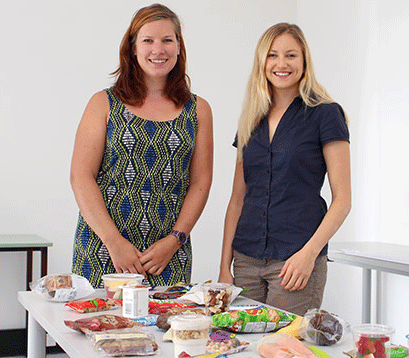Tuck into snack study
Young Australian adults have a world-leading appetite for snack foods but surprisingly little is known about their perceptions of nutritional value and portion size. Now, a new study at the University of Newcastle is putting the sweet tooth to the test.
 Nutrition behaviour scientists Dr Tamara Bucher and Nienke de Vlieger are looking to recruit 80 people aged 18-30 for a snack-sorting task and survey. The age demographic was chosen because early adulthood is considered a prime opportunity for behavioural change, with people leaving home and developing
new eating habits.
Nutrition behaviour scientists Dr Tamara Bucher and Nienke de Vlieger are looking to recruit 80 people aged 18-30 for a snack-sorting task and survey. The age demographic was chosen because early adulthood is considered a prime opportunity for behavioural change, with people leaving home and developing
new eating habits.
"We're interested in the criteria that these people use to evaluate the nutritiousness of various foods," Dr Bucher said. "However, we aren't promoting it as a health study because we don't only want to attract those who are interested in healthy eating.
"Participants in the control group will receive no information about the foods in front of them whereas others will receive either energy content information or the health star rating. We are keen to see whether people adjust their portion sizes and choices accordingly."
Previous trials have shown that nutritional data doesn't greatly influence consumer choice with soft drinks – this is the first involving snack foods, all of which are sold on the UON's Callaghan campus and elsewhere.
For the first part of the trial, participants serve what they consider to be reasonable portions of breakfast cereal, a lunch comprising plastic replicas of pan-fried chicken, chips and vegetables, then fake fruit salad and chocolate. In the second task they are asked to rank a variety of 32 real snacks ranging from fruits and nuts to chips, lollies and muffins.
"They sort them along a line ranging from 'not nutritious' to 'very nutritious', and through statistical analysis we can calculate how they evaluate the snacks. It will help us understand how people make healthy choices so we can better communicate the nutritional message," Dr Bucher said.
"There is no right or wrong answer because some people are more interested in minimising calories while others want high nutritional density."
On the star-rating system, chocolate scored a lowly half-star out of five. Fruit, yoghurts, a muesli bar and unsalted nuts were among the healthier choices, according to Dr Bucher, while a mega-sized blueberry muffin topped the energy count at 3000 kilojoules and was high in saturated fat.
"This muffin is more a meal than a snack," Dr Bucher adds. "It's interesting because people often look at the type of food and don't consider the size. They also assume that snacks like banana bread are a better choice but it's not necessarily so – the banana doesn't add much in the way of health."
Study participants can make an appointment to visit the ATC Building on the Callaghan campus by emailing nienke.devlieger@newcastle.edu.au. They will receive a free coffee voucher and a snack.
* Dr Bucher and Ms de Vlieger are members of the University of Newcastle's Priority Research Centre for Physical Activity and Nutrition , researching in conjunction with HMRI's Cardiovascular Program. HMRI is a partnership between the University of Newcastle, Hunter New England Health and the community.
Contact
- Media and Public Relations.
- Phone: 02 4921 5577.
Related news
- Launch of the School Students’ Statement on the Right to a Healthy Environment
- Funding boost to technology for lower emission steel
- Newcastle team on mission to improve childhood cancer outcomes
- Shanae’s passion for caring delivers her dream to work in health
- Food and nutrition degree serves Keren a rewarding career
The University of Newcastle acknowledges the traditional custodians of the lands within our footprint areas: Awabakal, Darkinjung, Biripai, Worimi, Wonnarua, and Eora Nations. We also pay respect to the wisdom of our Elders past and present.